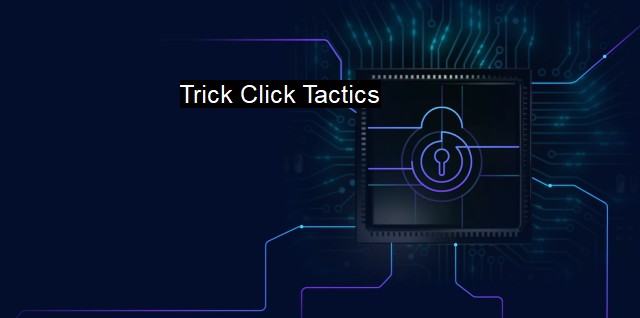What are Trick Click Tactics?
TCT: The Stealth Cyber-Attack Method Utilizing Social Engineering and Malware Tactics to Steal Sensitive Data"
"Trick Click Tactics" is an increasingly prevalent tool in cyberattacks used to deceive internet users into clicking on fraudulent links by disguising them as legitimate ones. This strategy often exploits the victims' impulsivity, trust, or curiosity to con them into engaging, giving the perpetrator access to their system, personal information, or even leading to financial fraud. These clicks can result in a variety of outcomes, ranging from the malicious downloading of software, ransomware attacks, election interference, to the breach of sensitive data.The trick click tactics serve the intention of luring users into prompt action and is frequently deployed in online ad campaigns, emails, text messages, and social media platforms and posts. The nature of these attacks varies extensively, depending on the intentions of the attacker. They can include drive-by downloads that install on your system without your consent simply by visiting an infected site, malicious links that seem harmless or enticing, to clickbait articles that can lure one in with their sensationalist headlines.
At the heart of trick click tactics are social engineering and persuasion theory methods. In these schemes, victims are made to believe they are navigating and interacting with secure, trustworthy sources. Impressive declarations, shocking news, or providing a sense of urgency often incite users to click on these links without scrutinizing their authenticity.
Phishing, one of the most common instances of trick click tactics, usually masquerades as bulwarks of credibility such as banks, government agencies, or trusted service providers. Users receive emails or messages prompting the urgent need for sensitive information verification or warning about potential security threats. By adopting a fear-inducing or ecologically trusted face, several individuals may fall prey to the scheme, divulging sensitive personal data or breaching their security in the process.
Malvertisement is another delivery mechanism for trick click tactics. Malvertisements are deceptive ads that lead you to download malicious programs once clicked. They often come cloaked in the form of inter-site interactive ads, special offer pop-ups, or push notifications; extorting a system's vulnerabilities to infiltrate them.
A classic instance of trick click tactics is clickjacking. Clickjacking attacks coerce the user into clicking on a concealed malicious link overlaid above a harmless or enticing feature or web page. The hidden layer could initiate several unwanted actions once engaged; this could be as harmless as auto-sharing a Facebook page or as destructive as initiating a ransomware attack.
Given the world's accelerating shift toward online activities and the myriad interactions carried out online, trick click tactics present an increasingly formidable threat. Fortunately, a host of antivirus software and cybersecurity mechanisms can mitigate these risks. Reliable antivirus applications can scan email links, web portals, files and can gallantly counter these intrusive and often detrimental objectives of tactics like phishing, clickjacking or malvertisements by blocking them or sending alert notifications for potential threats.
Different couples of antivirus tools can help strengthen system resiliency against these trick click tactics. With real-time protection, behaviour analysis, proactive AI detection, and regular software updates, these software protects, counters and alerts the users of potential threats. Users should practice safe browsing habits and be prudent. Being aware of what a typical trick click tactic may comprise, such as extraordinarily compelling advertisements, urgent requisitions, or security alert communications, could play a significant role in recognizing and prohibiting trespasses.
The cybersecurity landscape faces a challenging antagonist in trick click tactics. arming oneself with knowledge and awareness of these tactics, boosting online security and hygiene, and employing reliable antivirus protection software stands as the best means to dismantle any malevolent cyber intentions.

Trick Click Tactics FAQs
What is Trick Click Tactics?
Trick Click Tactics are tactics used by cybercriminals to trick users into clicking on malicious links or attachments. This is done through various forms of social engineering, including phishing emails, fake websites, and spoofed messages.How can I protect myself against Trick Click Tactics?
The best way to protect yourself against Trick Click Tactics is to practice safe browsing habits. This includes being cautious of unexpected emails or messages, not clicking on unknown links or attachments, and using up-to-date antivirus software. It is also important to stay informed about the latest threats and scams.What are some common signs of Trick Click Tactics?
Some common signs of Trick Click Tactics include unsolicited emails or messages, misspelled words or poor grammar, urgent or threatening language, and suspicious or unfamiliar sender addresses. It is important to be cautious of any unexpected or unusual communications, especially if they ask for sensitive information or request immediate action.What should I do if I think I have fallen victim to Trick Click Tactics?
If you think you have fallen victim to Trick Click Tactics, it is important to take immediate action. This may include running a virus scan on your computer, changing your passwords, and contacting your bank or credit card provider if your financial information was compromised. It is also recommended to report the incident to the appropriate authorities, such as the Federal Trade Commission or local law enforcement.| | A | | | B | | | C | | | D | | | E | | | F | | | G | | | H | | | I | | | J | | | K | | | L | | | M | |
| | N | | | O | | | P | | | Q | | | R | | | S | | | T | | | U | | | V | | | W | | | X | | | Y | | | Z | |
| | 1 | | | 2 | | | 3 | | | 4 | | | 7 | | | 8 | | |||||||